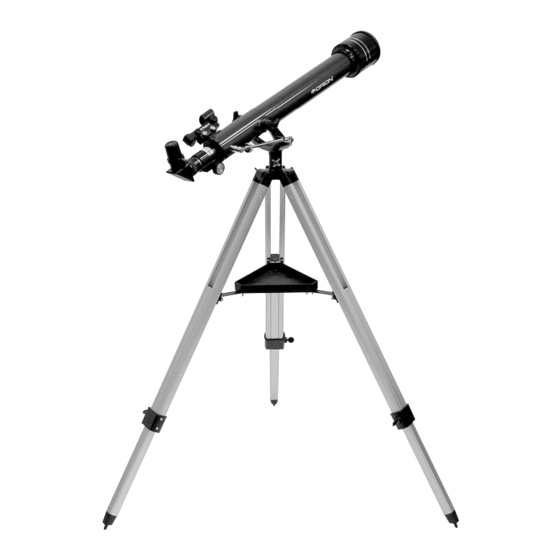
Table of Contents
Advertisement
Advertisement
Table of Contents

Summary of Contents for Orion Observer 60
- Page 1 Manual orion ® observer 60mm aZ ™ #9854 60mm Altazimuth Refracting Telescope customer support (800)‑676‑1343 E‑mail: support@telescope.com corporate offices (831)‑763‑7000 89 Hangar Way, Watsonville, ca 95076 Providing Exceptional Consumer Optical Products Since 1975 IN 194 Rev. B 02/09...
-
Page 3: Table Of Contents
Moon, star clusters and nebulas to glimpses of Jupiter’s moons and Saturn’s rings. The Observer 60 includes everything you need to go from box to backyard in less than half an hour. - Page 4 60 refractor ™ Figure 1. Observer 60 Components...
-
Page 5: The Basic Components
3. the Basic components of Your telescope Figure 1 shows the fully assembled Observer 60 . All the major components of the telescope are described and numbered to help you identify each part and understand its use. Refer back to this figure when assembling the telescope. - Page 6 60 telescope tube Figure 2a. Optical tube components Figure 2b. Observer 60 focuser detail...
- Page 7 ® Details of the optical tube and components Figure 2a shows the details of the optical tube and its various parts. The optical tube is shown attached to the mount for clarity. Figure 2b is a close-up of the focuser with even more detail. objective lens: Focuser drawtube: This is the main optical component of the telescope.
- Page 8 60 tripod and Mount Figure 3a. Tripod and mount detail Details of the tripod and Mount Figure 3a shows a close up of the telescope’s mount and tripod. Important features are pointed out for greater clarity and detail. altitude lock knob: leg lock knobs: These knobs lock the tripod legs into place.
-
Page 9: Assembly
4. Tighten the tripod leg attachment screws (21) at the tops of the tripod legs so the legs are securely fastened to the Figure 3b. Figure 4. Observer 60 Tripod leg and mount attachment detail Installing the optical tube in the “yoke” altazimuth mount... -
Page 10: Getting Started
5. Getting started Now that your Observer 60 is assembled, you’re ready to begin observing. This section will instruct you on using your telescope effectively. altitude and azimuth (aiming the telescope) Focusing the telescope The Observer 60 altazimuth mount permits motion along two With the 25mm Kellner eyepiece inserted into the 90°... - Page 11 When Note: The image in the eyepiece of the Observer 60 will be you look through the EZ Finder II, the red dot will appear to float reversed from left-to-right.
-
Page 12: Using Your Telescope
When viewing the with the Observer 60, you will need to give the are dark skies. You will be amazed at how many stars optical tube a light tug or push in azimuth (left or right) as well you can see when you get away from the city lights. - Page 13 Telescope Focal Length (mm) ÷ Eyepiece Focal higher magnifications well. Length(mm) = Magnification For example, the Observer 60, which has a focal length The best rule of thumb with eyepiece selection is to start of 700mm, used in combination with the 25mm eyepiece,...
- Page 14 Saturn are the brightest objects in the sky after the Sun and eras and have “false color” added. Our eyes are not sensitive the Moon. Your Observer 60 is capable of showing you these enough to see color in deep-sky objects except in a few of the planets in some detail.
-
Page 15: Specifications
Observer 60. Optical tube: Aluminum terrestrial Viewing Objective lens diameter: 60mm The Observer 60 can be used for long-distance viewing over Objective lens: Achromatic, air-spaced, coated land. We recommend using an optional 45° correct-image Focal length: 700mm prism diagonal instead of the included 90° mirror star diago- nal. - Page 16 This warranty is for the benefit of the original retail purchaser only. During this warranty period Orion Telescopes & Binoculars will repair or replace, at Orion’s option, any warranted instrument that proves to be defective, provided it is returned postage paid to: Orion Warranty Repair, 89 Hangar Way, Watsonville, CA 95076.










Need help?
Do you have a question about the Observer 60 and is the answer not in the manual?
Questions and answers